ATI's New High End and Mid Range: Radeon X1950 XTX & X1900 XT 256MB
by Derek Wilson on August 23, 2006 9:52 AM EST- Posted in
- GPUs
A Matter of Memory: Revisiting the Mid-Range
When 512MB cards first came along (with the GeForce 7800 GTX 512), we ran some performance tests to try and ascertain the real world performance difference between these cards and ones with 256MB of RAM. We came up empty handed at the time. Today we are able to show that memory sizes above 256MB are actually starting to matter. With ATI's launch of the new X1900 XT 256MB, we have a direct comparison between two cards which are almost identical aside from the amount of memory on board. To be completely fair, X1900 XT 256MB cards built by ATI will also have full HDCP support, keys and all, but the major difference remains RAM.
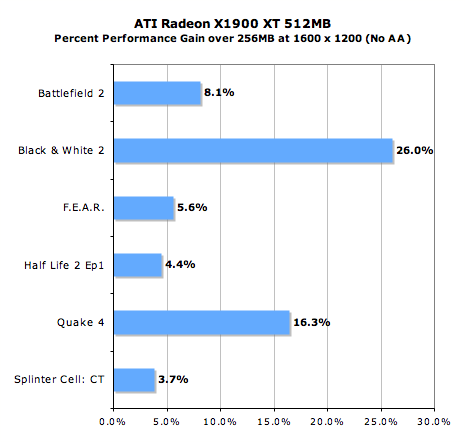
ATI dropped down to eight 8Mx32 as opposed to the eight 16Mx32 GDDR3 modules used on the original X1900 XT. Memory speed, bandwidth, and even layout can remain the same between cards, with only a slight difference in timings due to the different capabilities of each chip type. The result is that the X1900 XT 256MB is a slower solution than the X1900 XT that still offers exceptional performance for a terrific price.
The graphs below compare the new $279 X1900 XT 256MB to the rest of the sub-$300 cards we included in last week's mid-range GPU roundup. Note that the X1900 XT's chief competitor is NVIDIA's GeForce 7900 GT, which itself can be found for around $270. However, for as little as $20 more you can get a factory overclocked 7900 GT such as the eVGA GeForce 7900 GT KO SC clocked at 580/790 that all of the sudden becomes far more competitive. Because of the prevelance of factory overclocked (and warrantied) 7900 GTs, we've included the eVGA card as a reference of what you can get for the same price.
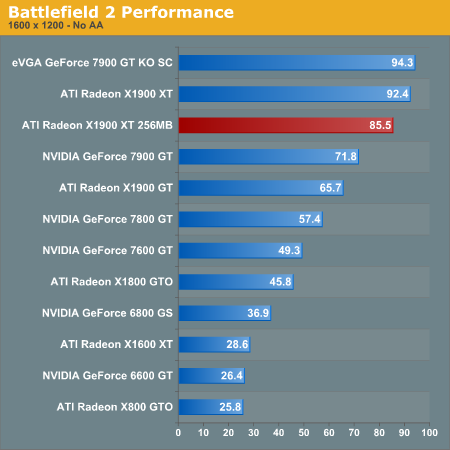
The 256MB drop in memory size doesn't impact BF2 enough to drop performance below the 7900 GT. The overclocked EVGA card does out perform even the 512MB X1900 XT in this test, but the 256MB version doesn't loose much value here as 85 fps is still way more than playable.
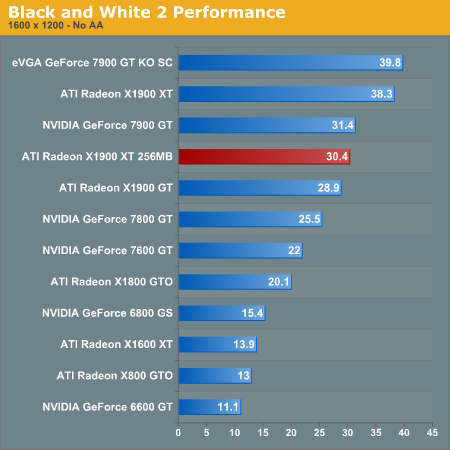
The 256MB X1900 XT falls in performance to just below the level of the stock 7900 GT. The competition is still tight, and we are about on par for the money here.
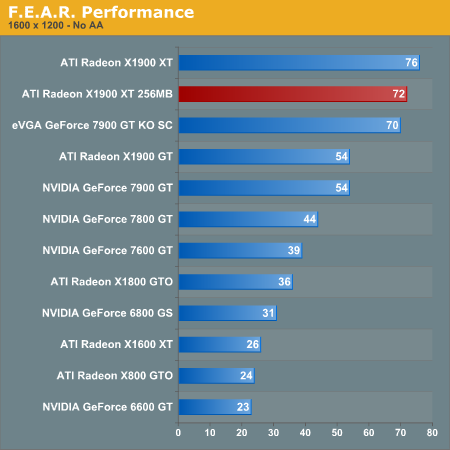
If F.E.A.R. performance is important to you, the X1900 XT 256MB is a better value than even the overclocked 7900 GT. The 512MB card still retains a small 5.5% lead over the 256MB card. This is one of the smaller performance drops we will see.
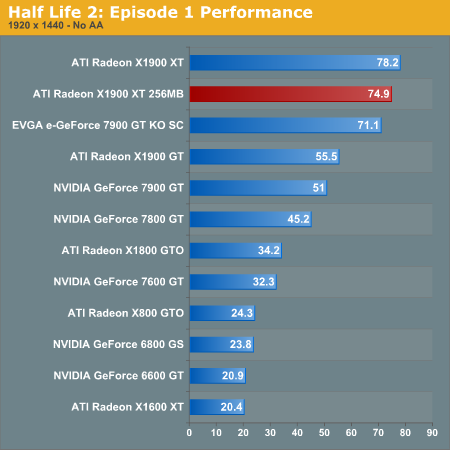
Under HL2:Ep1, performance drops a very small amount, but both X1900 XT cards are in strong competition with the overclocked 7900 GT.
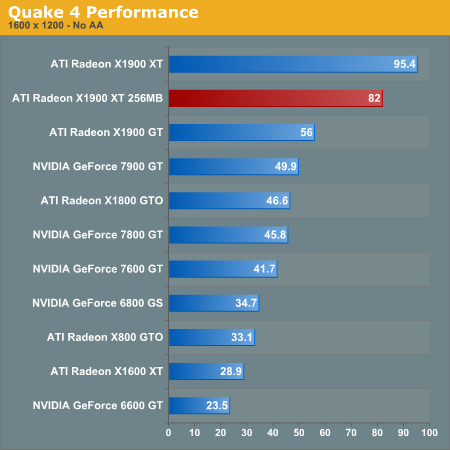
Quake 4 does give the 512MB card a bit of an advantage at 1600 x 1200, but the performance of the 256MB X1900 XT is still quite respectable given its target price of $279. The stock GeForce 7900 GT isn't in the same league as the X1900 XT.
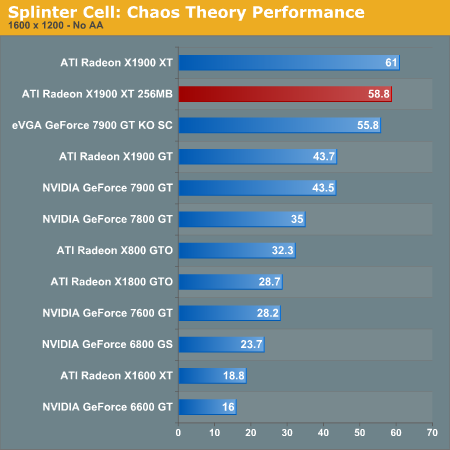
Spinter Cell rounds out our tests as one of those games where the larger frame buffer on the older X1900 XT does not do much. You lose less than 4% of your performance when going to the cheaper 256MB X1900 XT, which is a trade off we can live with. The regular GeForce 7900 GT can't hope to keep up with the 256MB X1900 XT, but if you get one of the factory overclocked cards such like the eVGA GeForce 7900 GT KO SC (more acronyms please) then you'll actually have performance competitive to the X1900 XT 256MB.
If the X1900 XT 256MB actually debuts at the ATI suggested price of $280, there won't be much of a reason to recommend anything but ATI parts from $220 up until we reach the highest end parts at above $400 where the lines start to blur again. While performance can fall very short of the X1900 XT 512MB at times, the X1900 XT 256MB remains competitive with our overclocked 7900 GT in every case but Black & White 2. The reduced memory version of the X1900 XT is just what ATI needed to pull out in order to fight back against the incredible overclockability of the 7900 GT.










74 Comments
View All Comments
Ecmaster76 - Wednesday, August 23, 2006 - link
Is it a GDDR3 or a DDR2 product?If the former, any chance it will crossfire with x1600 xt? Oficially I mean (methinks a bios flash might work, though x1650 is maybe a 80nm part)
coldpower27 - Wednesday, August 23, 2006 - link
No I don't think that would work.an X1650 Pro has 600/1400 Speeds so 100% sure is GDDR3, DDR2 doesn't exisit at such high clockspeed.
Genx87 - Wednesday, August 23, 2006 - link
Some of the other reviews had this x1950XT beating the GX2 almost every time, sometimes by a wide margin.I still cant get over the power\transistor\die size to performance advantage Nvidia has over ATI right now.
PrinceGaz - Wednesday, August 23, 2006 - link
Interesting. The first review I read was at where the X1950XTX beat or equalled the 7950GX2 every time, then here the reverse is true. I think I'll have to read more reviews to decide what is going on (it certainly isn't CPU limitations). Maybe 's focus on optimum quality settings rather than raw framerate is the reason they favoured ATI, and another is the clear fact that when it came to minimum framerates instead of average framerates ( posted both for all tests) the X1950XTX was especially good.In other words the 7950GX2 posted great average numbers, but the X1950XTX was playable at higher quality settings because the minimum framerate didn't drop so low. Hopefully some other sites also include minimum framerates along with graphs to clearly show the cards perform.
I remember a few years ago when ATs graphics card articles included image-quality comparisons and all sorts of other reports about how the cards compared in real-world situations. Now it seems all we get is a report on average framerate with a short comment that basically says "higher is better". Derek- I strongly suggest you look at how test cards and the informative and useful comments that accompany each graph. There may only have been three cards in their comparison but it gave a much better idea of how the cards compare to each other.
Anyway I'll not be getting any of these cards. My 6800GT has plenty of performance for now so I'll wait until Vista SP1 and the second-generation of DX10 cards which hopfully won't require a 1KW PSU :)
PrinceGaz - Wednesday, August 23, 2006 - link
It seems the comments system here uses the brackets in HardOCP's abbreviation as some sort of marker. Apologies for making the rest of the text invisible, please amend my comment appropriately. I was talking about HardOCP by the way, when I said they use minimum framerates and optimum quality settings for each card.JarredWalton - Wednesday, August 23, 2006 - link
Don't use {H} in the comments, please. Just like {B} turns on bold, {H} turns on highlighting (white text).
JarredWalton - Wednesday, August 23, 2006 - link
Ah, seems you figured that out already. ;) I need to see if we can disable that feature....haris - Wednesday, August 23, 2006 - link
Actually if you look at all of the reviews a bit more closely the sites the scores depend on which processor is being used for the test. It appears that nVidia cards tend to run better on Conroes(probably just means the games are slightly less cpu bottlenecked at the resolutions being tested) while ATi tends to run better on AMD systems(or when the cpu is slowing things down) Of course that is IIRC from the 5 reviews I skimmed through today.coldpower27 - Wednesday, August 23, 2006 - link
No just no X1950 XTX alone is not more powerful then the 7950GX2. Only in ATI favourable scenarios or where SLI flat out doesn't work will this occur.UNESC0 - Wednesday, August 23, 2006 - link
you might want to run dual monitors...